Entries tagged with “Franciacorta”.
Did you find what you wanted?
Tue 28 Dec 2010
Franciacorta sparkling wine comes from Lombardy, with DOCG status produced from grapes grown within the area of Franciacorta, south hills of Lake Iseo, in the Italian Province of Brescia. It was awarded DOC status in 1967, the designation then also including red and white still wines. Since 1995 the DOCG classification has applied exclusively to the sparkling wines of the area.
Grapes for Franciacorta are grown in strictly delimited vineyards in the communes of Adro, Capriolo, Cazzago San Martino, Cellatica, Coccaglio, Cologne, Corte Franca, Erbusco, Gussago, Iseo, Monticelli Brusati, Ome, Paderno Franciacorta, Paratico, Passirano, Provaglio d’Iseo, Rodengo Saiano, Rovato and Brescia, with soil conditions described as mineral-rich, granular-sized, calcareous gravel and sandy morainal soils that cover a limestone bedrock.
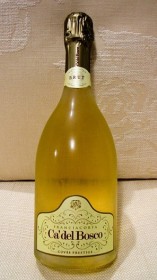 The DOCG declared vineyards extend 2,200hectares (5,400 acrres) and the distribution of permitted grape varieties are 85% Chardonnay, 10% Pinot nero and 5% Pinot bianco.
The DOCG declared vineyards extend 2,200hectares (5,400 acrres) and the distribution of permitted grape varieties are 85% Chardonnay, 10% Pinot nero and 5% Pinot bianco.
Nonvintage Franciacorta (NV) may not be released until at least 25 months after harvest, of which 18 months must be in contact with the yeast in the bottle (compared to 15 months in the case of Champagne). Franciacorta Vintage or Millesimato may not be sold until at least 37 months after harvest, of which 30 months must be in contact with the yeast (similar to Champagne). A Franciacorta rosé must contain at least 15% Pinot nero, and may be made by blending red wine. Franciacorta Satèn must be a Blanc de blancs with only the use of Chardonnay and/or Pinot bianco permitted, with only 4.5 atmospheres of pressure instead of 6.
Recently our friend and wine guru Gary Chevsky participated in a tasting event and these are his thoughts:
“On the heels of a great Champagne tasting this weekend at Santana Row’s Vintage Wine Merchants, I was itching for more sparkles. Kudos to Vintage for putting together an excellent line-up of Champagnes for a meager $40 ($25 for members) – they certainly packed the shop, and the punters were not disappointed.
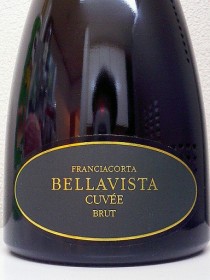 This was the first time I had the 1999 Dom Perignon, and it was probably my fave Dom P, showing the classical well-developed nuttiness. Compared to it, the just released 2002 was too young and simple at this stage. Other notables were the always reliable and incredibly inexpensive Hiedsieck & Co “Blue Top” ($25-30), the elegant Delamotte ($35, Salon’s little sibling), and the well-regarded higher-end Champagnes by Pol Roger (Reserve), Egly-Ouriet (Brut Tradition Grand Cru), and Gosset (Brut Grand Reserve).
This was the first time I had the 1999 Dom Perignon, and it was probably my fave Dom P, showing the classical well-developed nuttiness. Compared to it, the just released 2002 was too young and simple at this stage. Other notables were the always reliable and incredibly inexpensive Hiedsieck & Co “Blue Top” ($25-30), the elegant Delamotte ($35, Salon’s little sibling), and the well-regarded higher-end Champagnes by Pol Roger (Reserve), Egly-Ouriet (Brut Tradition Grand Cru), and Gosset (Brut Grand Reserve).
That was Sunday. On Monday, my faith in Champagne re-affirmed, it was now Italy’s turn to impress.
I am a big fan of Franciacorta. Italy’s answer to Champagne, it can be every bit as profound. Made in the traditional method (aka Champagne method) where the second fermentation and ageing on the lees take place in bottle, Franciacorta can evolve beautifully over many years, especially vintage examples, and can also be enjoyed young. Last night my wine/tennis group had a re-union (after I tore my achilles tendon earlier this year) at our local de-facto standard seafood hole-in-the-wall – the legendary Old Port Lobster Shack in Redwood City. To grease the wheels, we brought two of the most highly regarded Franciacorta producers – Bellavista and Ca’del Bosco. And the good news – Franciacorta, although being unknown in the non-wine circles, is readily available in this country. I got mine from WineChateau.com (Bellavista and Ca’del Bosco). Seafood, fries and sparkling wine – how can you go wrong with that combo?!
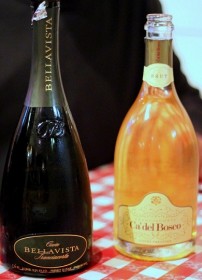 We didn’t. The Lobster Shack’s naked lobster roll is fabulous, and their beer-battered fish and chips are out of this world. But the dish that both Franciacortas really shone with was steamed mussels – petite, tender, flavorful in a great broth begging for dipped bread. Eric suggested that the wine really brought out the minerally tones in the mussels. I thought it went well even with the creamy New England clam chowder – another not-to-be-missed beauty from the Shack.
We didn’t. The Lobster Shack’s naked lobster roll is fabulous, and their beer-battered fish and chips are out of this world. But the dish that both Franciacortas really shone with was steamed mussels – petite, tender, flavorful in a great broth begging for dipped bread. Eric suggested that the wine really brought out the minerally tones in the mussels. I thought it went well even with the creamy New England clam chowder – another not-to-be-missed beauty from the Shack.
I gotta say – on a relatively quiet Monday night, we spent three hours chilling at this characterful joint. The folks there, especially the hostess Shay, are so friendly, she reminded me of my mom. Everyone had a great time, and with tongues un-tied, we reminisced of the old tennis follies and the crazy things that happen in the wine circles.
Bellavista is an old classic Franciacorta producer, and their non-vintage cuvee was a more serious expression than Ca’del Bosco’s floral and lemony entry level cuvee “Prestige” – an all-time dependable friend, that I always keep stocked in my cellar. Just for the heck of it, we followed with beers, and agreed that Franciacorta was a better, lighter, more elegant match. Enjoy!”
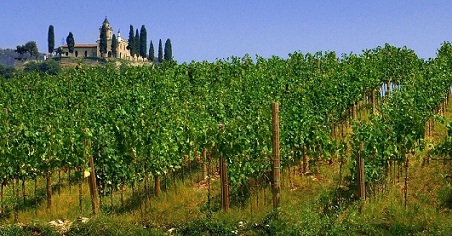
Wed 20 Oct 2010
One of the best regarded Italian wine guides, Gambero Rosso Vini d’Italia, was realised last week. It is a survey of the best Italian wines and winemakers, divided by region. The best are awarded stars, between 1 and 3, depending on the quality of their wines and its continuity year after year. In this year’s guide there were 402 wines awarded stars, as opposed to 391 last year.
In terms of producers, 386 of them were awarded stars by Gambero Rosso’s experts, as opposed to 366 last year.
Particular attention was given this year to wines with great quality/price ratio, with 52 of the wines awarded 3 stars offering great value, with a retail price of €15 or below.
This is the regional ranking: Piemonte (81) followed by Toscana (69), Veneto (35), Friuli (31), l’Alto-Adige (27), Lombardia (21), Campania (19), Marche (17), Sicilia (15), l’Emilia Romagna (13) Abruzzo (13), Sardegna (11), Puglia (10), Trentino (9), Umbria (9), Liguria (7), Valle d’Aosta (6), Basilicata (3), Lazio (3), Calabria (2) and finally Molise (1).
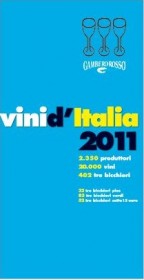 Below are the results of this year’s special awards:
Below are the results of this year’s special awards:
Winery of the year: Cantina Valentini of Abruzzi
Red wine of the year: Brunello di Montalcino Riserva ‘04 Biondi Santi
White wine of the year: A.A. Sylvaner R ‘09 Köfererhof
Sparkling wine of the year: Franciacorta Brut Secolo Novo ’05 Le Marchesine
Sweet wine of the year: Albana di Romagna Passito Ris. ‘06 Fattoria Zerbina
Wine-maker of the year: Walter Massa
Oenologist of the year: Ruben Larentis
Emerging Italian winery: Polvanera of Puglia
Best quality/price ratio: Verdicchio dei Castelli di Jesi Cl. Sup. ’09 Pievalta
This is the second year the Vini d’Italia guide is solely produced by Gambero Rosso, after its split from SlowFood in 2010. Other distinguished Italian wine guides include: L’Espresso’s I Vini d’Italia, Duemilavini of AIS (the Italian Sommelier Association), I Vini di Veronelli and Slow Wine of Slow Food Group.
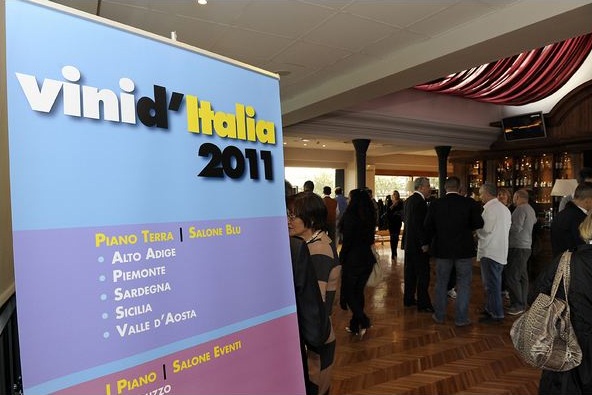
Thu 16 Sep 2010
Our wine guru Gary Chevsky enjoyed a tasting event for Italian red and white wines back in August, and shared his views with us:
“At the Chambers & Chambers trade tasting this week, I had a chance to visit and revisit many wines from all over Italy. Gourmet thin-crust pizzas from Lulu restaurant in the SOMA district of San Francisco complemented what seemed like 80-100 wines. About half the wines at the tasting were imported through Dalla Terra, founded by Brian Larky, a very funny dude. But funny is obviously not all he is – because Dalla Terra is a clever concept. They essentially eliminate one of the tiers in a 4-tier wine import distribution system, through their Winery Direct program.
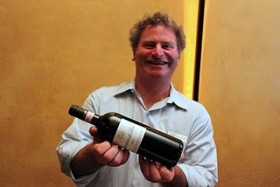 In 1989 Brian returned to the U.S. after five years as winemaker at one of my favorite sparkling wine producers in the world – Italian estate Ca’del Bosco, who makes the top Franciacorta (in Lombardy) that easily rivals top Champagne. Even Ca’del Bosco’s entry-level cuvee “Prestige” is a perennial great value sparkler. Brian founded Dalla Terra Importers in 1990. Before working in Italy, he’d earned a UC Davis Fermentation Sciences degree and held production jobs in Napa Valley wineries such as Far Niente and Domaine Chandon. Don’t be fulled by the effusive smile – the dude is clearly not just a funny dude. Whereas a usual importer markup could be 30-40%, Dalla Terra’s fee is only 15%, and that’s enough for them to run a profitable business for the past 20 years. That’s because unlike a traditional importer who has to buy and hold the inventory from the producer, Dalla Terra are a broker.
In 1989 Brian returned to the U.S. after five years as winemaker at one of my favorite sparkling wine producers in the world – Italian estate Ca’del Bosco, who makes the top Franciacorta (in Lombardy) that easily rivals top Champagne. Even Ca’del Bosco’s entry-level cuvee “Prestige” is a perennial great value sparkler. Brian founded Dalla Terra Importers in 1990. Before working in Italy, he’d earned a UC Davis Fermentation Sciences degree and held production jobs in Napa Valley wineries such as Far Niente and Domaine Chandon. Don’t be fulled by the effusive smile – the dude is clearly not just a funny dude. Whereas a usual importer markup could be 30-40%, Dalla Terra’s fee is only 15%, and that’s enough for them to run a profitable business for the past 20 years. That’s because unlike a traditional importer who has to buy and hold the inventory from the producer, Dalla Terra are a broker.
The concept is relatively common with domestic wines, but quite innovative (and difficult to implement) with imports. They never buy the wine – they connect the winery with a local US state distributor (like Chambers & Chambers), so they never have to shell out the big bucks necessary to hold the wine. Nor do they take the risk of inventory not selling. That is, the risk sits with the winery; therefore it’s reasonable to assume that the winery would retain a larger piece of the pie by quoting a relatively higher price to the distributor than they would to an importer. It’s hard to say though. I went to Wine-Searcher.com – the world’s most trusted wine comparison shopping engine – to compare local US prices to those on the Italian market of some of Dalla Terra’s wines, such as Casanova di Neri and Vietti. I found there is about a 40-50% markup in US over Italy. I then looked at some other high-end Italian producers, such as Il Poggione, Fattoria di Felsina, and Marcarini imported though Southern Wine & Spirits, Wine Warehouse, and Empson USA respectively. US prices were 40% to 125% above the Italian prices. So the price benefits of Dalla Terra were not obvious to me, but this is by no means a scientific study, and I welcome comments from folks in the wine industry. In an interview, Brian told me that Dalla Terra have about 18 producers in their all-Italian portfolio, and in 20 years they haven’t lost one. “That speaks volumes for the type of business partner we are and the type of business we bring.” said Brian.
Here are the wines I particularly enjoyed at the tasting.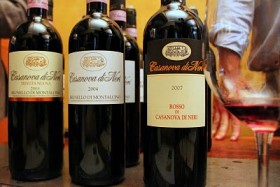
The Reds
Casanova di Neri Brunello di Montalcino 2004. This was their basic “white label” Brunello. (The 2001 Casanova di Neri Brunello made a splash with their higher-end “Tenuto Nuova” cuvee by being Wine Spectator’s #1 wine of the year in 2006.) Had this basic Brunello at the tasting and, more importantly, at a dinner next day. The wine is from the excellent 2004 vintage and is showing very well – juicy fruit, good acidity, tasty tannins. Exploding with aromas and fruit flavors, the wine is light enough to even go with fish, thanks to the excellent acidity and medium body. Delicious.
Marchesi di Gresy Barbaresco “Martinenga” 2006. Sweet, charming, red fruit, beautiful strawberry / cranberry color, gentle Nebbiolo texture, and the most accessible of any 2006 Barbarescos/Barolos I’ve tried so far. 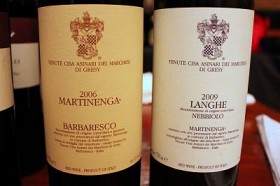
Vietti Barolo “Castiglione” 2006 – structured with slight menthol character, complex. It was the best wine match with the gourmet sausage pizza. The 2006’s are starting to open up. The 2005 “Brunate” didn’t have the menthol, but was also good. Dependable, top producer of Barolo, Vietti’s Barolo Lazzarito 2005 impressed me at the 2010 Tre Bicchieri tasting earlier this year. Their Barbera and Arneis are good too.
Vietti Barbera d’Alba “Scarrone Vigna Vecchia” 2006. Wonderfully balanced, rich, plush Barbera that tips to the much-maligned modern style, yet the delicious factor is undeniable. The most expensive Barbera I’ve ever seen ($75-100 retail). Rare, from a tiny lot in the prime Nebbiolo-caliber vineyard in Castiglione. More of a curiousity item, in my opinion, since in that price range, the wine has to be hand-sold to affluent buyers, looking for something “different”, and will be competing with high-end Barolos and Brunellos. For those who are willing to shell out big bucks for “something different”, there are options in Taurasi (from Campania), Sagrantino di Montefalco (from Umbria), and Etna Rosso (from Sicily) that come to mind before Barbera. Good wine, tough sell. 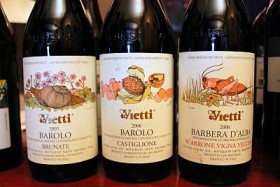
Roccolo Grassi Valpolicella Superiore “Roccolo Grassi” 2007. Single vineyard. Solid.
Roccolo Grassi Amarone “Selezione Antonio Castagnedi” 2006. All three of the Roccolo Grassi wines (including a white, mentioned below) were excellent. A producer to pay attention to. The 16-17% alc. the Amarone didn’t taste hot at all.
Selvapiana Chianti Rufina Riserva “Bucerchiale” 2006 – from a great vintage in Tuscany, excellent structure and texture, medium body. The detractor was notable heat on the palate – and lo and behold, the wine was a whopping (for a Chianti) 14-15% alc.
Cherchi Cannonau di Sardegna Rosso 2009 – good example of the native Cannonau grape of Sardinia. Very drinkable and food-friendly.
Vignalta “Gemola” 2004 – “Super-tuscan” from Veneto! (blend of Merlot and Cab Franc) – flagship of the Vignalta portfolio, well-balanced fruit/veggie, right-bank-Bordeaux like. Liked it both times. Nice effort. 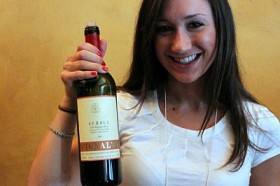
The Whites
Italian whites are a myriad of grape varietals and regions. Generally unoaked or low-oaked, crisp, food friendly, and quite interchangeable. I find Soave (from Veneto), Arneis (from Roero, Piedmont) and Ribolla Gialla (from Friuli) generally to my highest liking. But I enjoy many others depending on the particulars.
Vietti Arneis 2009 – good.
Roccolo Grassi Soave “La Broia” 2007. All three Roccol Grassi’s wines (including two reds mentioned above) were good.
Inama Soave Classico Superiore “Vigneti di Foscarino” 2007. More generous (but tasteful) oak treatment made this wine richer, more complex, more serious than a typical Soave, clearly showing the range of the Garganega grape of which Soave is made. Very good.
Marco Felluga Collio Bianco “Molamatta” 2008. Blend of Pinot Bianco, and the native Tocai Friulano and Ribolla Gialla.
A tasting like this reminds me how much I love Italian wine. And the photos of those pizzas next to the above-mentioned vino make me salivate. It’s almost lunch time here. I’m hungry. How about you?”
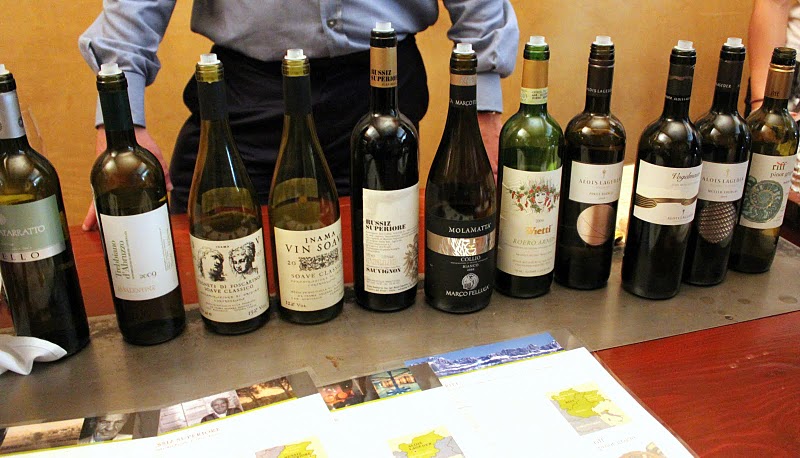
Tags: Amarone, Arneis, Barbaresco, Barbera d'Alba, Barolo, Brunello, Ca'del Bosco, Casanova di Neri, Cherchi, Dalla Terra, Franciacorta, Marchesi di Gresy, Marco Felluga, Piedmont, Roccolo Grassi, Soave, Valpolicella, Veneto, Vietti, Vignalta
Fri 18 Jun 2010
Our wine guru Gary Chevsky visited the annual Gambero Rosso “Tre Bicchieri” event in San Francisco, back in February:
“On Feb 24, one of my favorite trade tasting events of the year arrived to San Francisco. For background on Gambero Rosso and their Tre Bicchieri event, see my coverage of the last year’s event. The world of Italian wine is diverse and complicated. And wonderful. Tre Bicchieri really gives you a chance to sample across the whole of Italy, and to celebrate the variety and the quality all in one place. So without further ado, I will jump straight into my impressions:
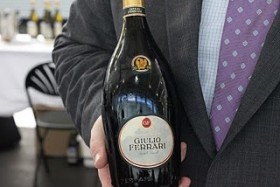
1. The biggest thing that strikes you at an event like this is just how there is always a great new unfamiliar type of wine showing up. This year, I have to give it to Sparkling. The taste and quality of the Italian sparklers is astounding. And I am not talking about Prosecco (which usually leaves me cold). I am talking about Franciacorta DOCG (in the north of Italy, in Lombardy region) and Trento DOC (in the north of Italy, in Trentino – Alto Adige region). These are serious wines made in the traditional method of Champagne. Price is a big problem for these relatively obscure (in the US) appellations, and one more reason why you don’t see a lot of them in this country. Are you willing to shell out $40-100 on an Italian sparker? (After having tasted them, I am!) Here are two of my faves:
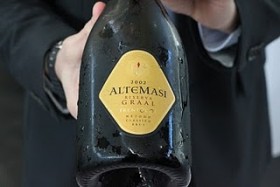 - “Trento Altemasi Graal Brut Riserva 2002” by Cavit – great nose, rich and lush apple syrup;
- “Trento Altemasi Graal Brut Riserva 2002” by Cavit – great nose, rich and lush apple syrup;
- “Trento Giulio Ferrari Riserva del Fondatore Brut 2000” by Ferrari – yeasty, bready, drier and more refined than Altemasi.
I noted them last year as well, but at that time Ca’del Bosco Franciacorta (absent this year) stole my heart.
2. A strong showing for young Amarones this year. Complexity & freshness, rather than an often-seen raisiny fruit. Amarone della Valpolicella Classico Campolongo di Torbe 2004 by Masi (still a year till official release) was ripe, juicy, meaty, spicy and fresh. An honorable mention goes to Guerrieri Rizzardi’s Amarone della Valpolicella Classico Villa Rizzardi 2005 – sweet, slightly herbaceous nose, bitter sweet on the palate.
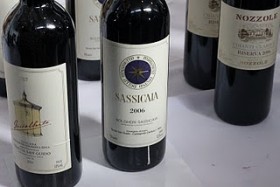 3. I must say the event seemed “poorer” this year, as most of the cult names were not there. I did see Sassicaia. That’s about it. The food was just cheese, crackers, and fruit. Nor did I see the Tre Bicchieri guides or even cork-screws given away like I’d spotted a year ago.
3. I must say the event seemed “poorer” this year, as most of the cult names were not there. I did see Sassicaia. That’s about it. The food was just cheese, crackers, and fruit. Nor did I see the Tre Bicchieri guides or even cork-screws given away like I’d spotted a year ago.
4. Relatively thin showing by Barolo and Brunello reminded me that there are fewer celebrated wines in the most recent release (2005) than a year ago (2004). Only one Brunello stood out for me – Canalicchio di Sopra 2004 – young, fresh and tasty! There were some excellent examples of 2005 Barolo. The charming and talented Giuseppe Vaira delivered on his Barolo Bricco delle Viole 2005 – sweet, soft-textured, intensely flavored, plum, tea, with loads of dark berries. Vietti’s Barolo Lazzarito 2005 was a classic – a powerhouse Nebbiolo, full-flavored, jerky, tannin, serious, young, deep, concentrated black cherry. Several other wines were solid though not amazing – Oddero Barolo Mondoca di Bussia Soprana 2004 (blueberry/cherry tea), Elvio Cogno Barolo V. Elena 2004 (soft and charming), Bezza & Figli Barolo Sarmassa 2005 (toothpasty fresh tea), Travaglini Gattinara Riserva 2004 (meaty and gritty), Prunotto Barolo Bussia 2005 (light & tart), and finally Pio Cesare Barolo Ornato 2005 (herb, spice and blackberry with a unique personality). So long as we are on the subject of Nebbiolo, a notable mention should also go to Ca’del Baio’s Barbaresco Asili 2006 – sweet and tart, slightly spicy, intense and substantive, tannic, with a touch of coffee, poured by the friendly winemaker sisters – Paola and Valentina Grasso.
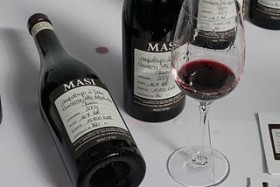 5. Bordeaux varietals and super-tuscans (or Toscana) were all the rage. A lot of good quality Cabs, Merlots, and Bordeaux blends some enhanced with Sangiovese, reminiscent of Bordeaux but with zingier acidity that I so love in Italian wine. The 2006 Bolgheri Sassicaia by Tenuta San Guido was expectedly outstanding (97pts Antonio Galloni, $150 retail) – dusty plum, nice tannins, a slight green component that added to the complexity, very good! The first vintage (2006) of Coevo by Cecchi was excellent too – flavor taking me to the right-bank of Bordeaux, great balance and complexity, 50% Sangio / 10% Cab / 20% Merlot / 20% Petit Verdot, dry blackberries, jerky. Galatrona 2007 (98pts Wine Spectator) from Petrolo, made from 100% Merlot, was a powerhouse gorgeous beast of a wine – veggie and spice, fresh, super-concentrated thick dark berry fruit. If Sassicaia were Pierce Brosnan, the Galatrona was Arnold Schwarzenegger.
5. Bordeaux varietals and super-tuscans (or Toscana) were all the rage. A lot of good quality Cabs, Merlots, and Bordeaux blends some enhanced with Sangiovese, reminiscent of Bordeaux but with zingier acidity that I so love in Italian wine. The 2006 Bolgheri Sassicaia by Tenuta San Guido was expectedly outstanding (97pts Antonio Galloni, $150 retail) – dusty plum, nice tannins, a slight green component that added to the complexity, very good! The first vintage (2006) of Coevo by Cecchi was excellent too – flavor taking me to the right-bank of Bordeaux, great balance and complexity, 50% Sangio / 10% Cab / 20% Merlot / 20% Petit Verdot, dry blackberries, jerky. Galatrona 2007 (98pts Wine Spectator) from Petrolo, made from 100% Merlot, was a powerhouse gorgeous beast of a wine – veggie and spice, fresh, super-concentrated thick dark berry fruit. If Sassicaia were Pierce Brosnan, the Galatrona was Arnold Schwarzenegger.
6. Tre Bicchieri wines (at least all the ones I was drawn to taste) are expensive. Definitely if you want the good stuff, brace yourself — you will pay just as much as for high-end French. I don’t see any obvious “value” categories at the Tre Bicchieri level.
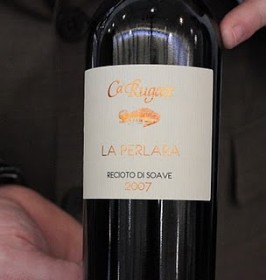 7. Recioto di Soave was a revelation. La Perlara 2007 by Ca’Rugate – a sweet wine of considerable complexity was perhaps the 2nd best Italian sweet white I’d ever had, bested only by the Vin Santo di Montepulciano Avignonesi 1996 from last year’s event. Being more familiar with Recioto di Valpolicella (a sweet red wine), I learned that “recioto” style of winemaking (where grapes are dried on mats for months, vinified somewhere along the way to raisinhood) is also applied to white wine made in Soave from the Garganega grape (in Veneto, in the northeast of Italy, neighboring with Valpolicella).
7. Recioto di Soave was a revelation. La Perlara 2007 by Ca’Rugate – a sweet wine of considerable complexity was perhaps the 2nd best Italian sweet white I’d ever had, bested only by the Vin Santo di Montepulciano Avignonesi 1996 from last year’s event. Being more familiar with Recioto di Valpolicella (a sweet red wine), I learned that “recioto” style of winemaking (where grapes are dried on mats for months, vinified somewhere along the way to raisinhood) is also applied to white wine made in Soave from the Garganega grape (in Veneto, in the northeast of Italy, neighboring with Valpolicella).
8. Some outstanding wines are not imported to California (or the US altogether). The Recioto di Soave above was one of them. Several more that stood out for me were:
a) Franciacorta Saten 2006 sparkler by Il Mosnel - 100% chardonnay, fresh rich lemon custard;
b) Barbera d’Asti Superiore Nizza 2006 by Tenuta Olim Bauda – rich, fresh, balanced, a fairly substantial Barbera; 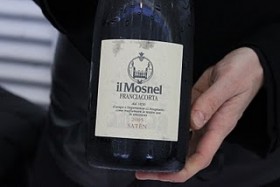
c) Chianti Classico Riserva 2006 by Tenuta di Capraia – good balance, fruit, great acid, nice soft texture/tannin.
After 5 tooth-staining hours of pacing myself through the aisles, I was exhausted. The wines I commented on here, I re-tasted 2-3 times throughout the evening, doing my part in delivering diligent assessment to you, my readers. I know, I know – it’s a tough job, but someone’s gotta do it!”

Tags: Amarone, Barolo, Brunello, Ca'del Bosco, Cavit, Ferrari, Franciacorta, Gambero Rosso, Il Mosnel, Masi, Sassicaia, Tenuta di Capraia, Tenuta Olim Bauda, Tre Bicchieri, Trento DOC, Valpolicella
 The DOCG declared vineyards extend 2,200hectares (5,400 acrres) and the distribution of permitted grape varieties are 85% Chardonnay, 10% Pinot nero and 5% Pinot bianco.
The DOCG declared vineyards extend 2,200hectares (5,400 acrres) and the distribution of permitted grape varieties are 85% Chardonnay, 10% Pinot nero and 5% Pinot bianco. This was the first time I had the 1999 Dom Perignon, and it was probably my fave Dom P, showing the classical well-developed nuttiness. Compared to it, the just released 2002 was too young and simple at this stage. Other notables were the always reliable and incredibly inexpensive Hiedsieck & Co “Blue Top” ($25-30), the elegant Delamotte ($35, Salon’s little sibling), and the well-regarded higher-end Champagnes by Pol Roger (Reserve), Egly-Ouriet (Brut Tradition Grand Cru), and Gosset (Brut Grand Reserve).
This was the first time I had the 1999 Dom Perignon, and it was probably my fave Dom P, showing the classical well-developed nuttiness. Compared to it, the just released 2002 was too young and simple at this stage. Other notables were the always reliable and incredibly inexpensive Hiedsieck & Co “Blue Top” ($25-30), the elegant Delamotte ($35, Salon’s little sibling), and the well-regarded higher-end Champagnes by Pol Roger (Reserve), Egly-Ouriet (Brut Tradition Grand Cru), and Gosset (Brut Grand Reserve). We didn’t. The Lobster Shack’s naked lobster roll is fabulous, and their beer-battered fish and chips are out of this world. But the dish that both Franciacortas really shone with was steamed mussels – petite, tender, flavorful in a great broth begging for dipped bread. Eric suggested that the wine really brought out the minerally tones in the mussels. I thought it went well even with the creamy New England clam chowder – another not-to-be-missed beauty from the Shack.
We didn’t. The Lobster Shack’s naked lobster roll is fabulous, and their beer-battered fish and chips are out of this world. But the dish that both Franciacortas really shone with was steamed mussels – petite, tender, flavorful in a great broth begging for dipped bread. Eric suggested that the wine really brought out the minerally tones in the mussels. I thought it went well even with the creamy New England clam chowder – another not-to-be-missed beauty from the Shack.






















